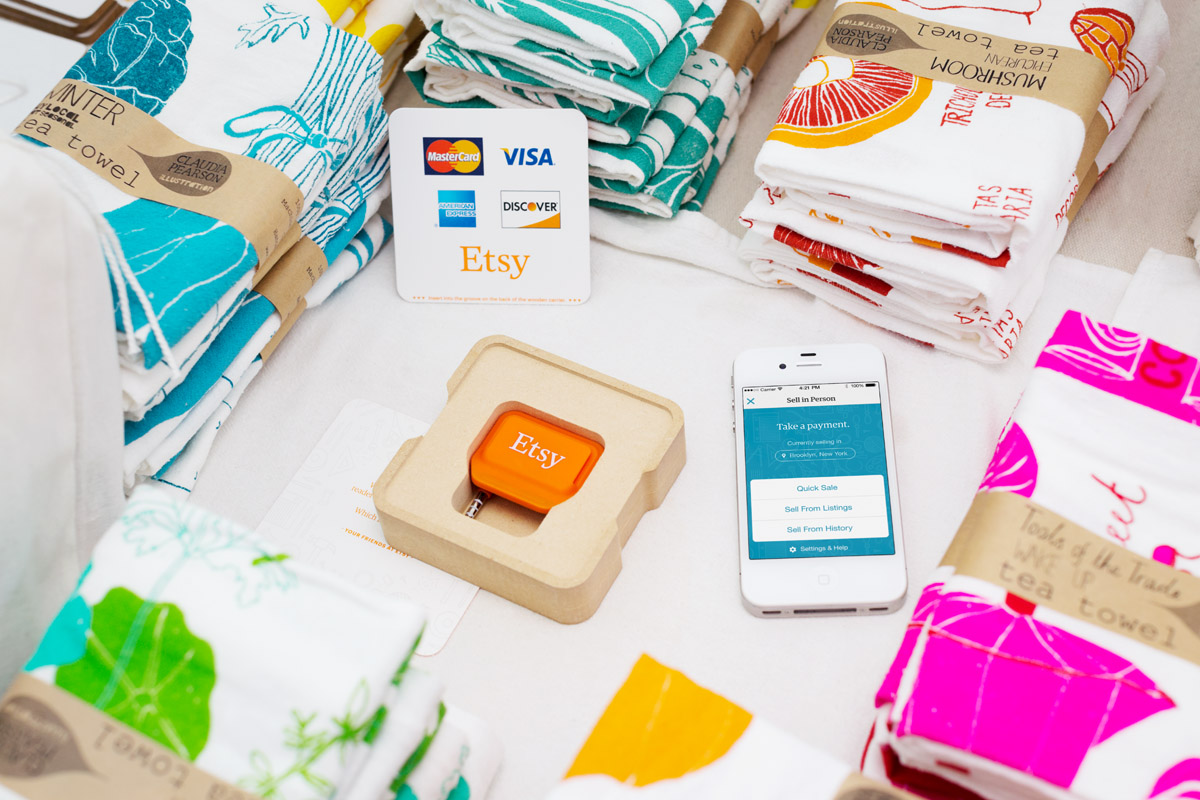How to make a living on Etsy
Part of our series on the future of Main Street


Throughout history, it was rare for two humans to own two identical products with the exact same cut, construction, material, or design. The Industrial Age changed all that — and ushered in mass production, assembly lines, the Sears and Roebuck catalog, and so much more. Today, you can buy a bridesmaid's dress off a rack in California and be certain it is the exact same one your sister purchased off the rack in Maryland.
But bridesmaid dresses aside, a lot of people don't want to buy the same dress as their sister across the country. They want to bring intimacy and individualism back to commerce.
That's where Etsy comes in. Etsy is the largest online market for handmade crafts (and more recently, antiques) in the world. This isn't just the smattering of crocheted potholders and hook rugs you might associate with a craft fair. Etsy has 43.9 million people buying and selling on their site, and 26 million unique items listed for sale. These items range from those crocheted potholders (4,004 of them to choose from) all the way up to this steampunk snail sculpture, listed for about $245,000.
The Week
Escape your echo chamber. Get the facts behind the news, plus analysis from multiple perspectives.

Sign up for The Week's Free Newsletters
From our morning news briefing to a weekly Good News Newsletter, get the best of The Week delivered directly to your inbox.
From our morning news briefing to a weekly Good News Newsletter, get the best of The Week delivered directly to your inbox.
And guess what: You can make a living wage selling your creative output on the internet. This is a booming new sector of the small business economy.
Jennifer Garrison owns the Etsy store Winterberry Jewelry, which specializes in charm jewelry. She's had over 3,000 sales since 2009. Like many women, Garrison had a handicraft she did for fun; making jewelry for herself and friends. Then it occurred to her that fun could be profitable.
"I decided to start selling because I had a lot of positive feedback from giftees who I gave things to. And also and because I was going broke buying supplies. Supplies always come in multiples so after making a project I'd always have more things left over."
Jody Dunse, owner of My Kid's Drawers, also supports herself through her Etsy shop. MKD specializes in making unique thematic dresses for children. Like Garrison, Dunse loved her hobby and decided to try and make money off of it.
A free daily email with the biggest news stories of the day – and the best features from TheWeek.com
"My girls, and then my granddaughters, grew out of the princess stage, but I didn't. I still loved to sew and I missed it. So, I started listing a couple of dresses here and there on Etsy. Over the years it's grown into a full-time business."
If Dunse's Etsy storefront looks a little bare, it's because she doesn't use Etsy as a display case, like most sellers do. Her store isn't a selection of items ready to ship. Instead, she periodically creates genuine "fashion lines" which, when finished, she uploads for her followers to buy. The themes of the dresses vary, modeled on anything from Disney villains to Dr. Who. But each dress bears her unique combination of sweet without saccharine and feminine without fluff. Her stock sells very quickly, and the storefront shows what's left after the stampede. Though she uses Etsy for the actual transactions, the best way to understand what makes Dunse's style special is to glance at her Pinterest page.
In fact, Dunse owes a lot of her Etsy success to Pinterest.
"I was selling part time on Etsy, starting to get busier, when a blogger pinned a picture of my dresses. That pin was repinned several thousand times, with the unfortunate title "All the princesses, just one pattern." I don't sell my patterns. Truthfully, I don't have a pattern that anyone else could make sense of. But I still get messages asking to buy the Princess patterns, they come in clusters, and I know 'The Pin' has resurfaced. Many of my 'original' customers came from that pin, then word of mouth in Facebook groups."
Few Etsy sellers are so lucky; most have to build their customer base slowly. But once that base is established, there are several things a seller can do to cultivate a thriving business.
1. Utilize more than one social media platform.
Garrison's creations, under different names, can also be found on such selling sites as Artfire and Ebay. Dunse sells only on Etsy, but builds her reputation on Facebook and Pinterest, two mediums well suited to her particular merchandise.
2. Don't take on more than you can handle.
Etsy recently changed its rules to allow its contributors to employ people to help produce, administer, and ship products, as long as the item itself resulted from the unique and personal design of the shop owner. The whole point is to keep things "handmade" instead of mass produced, but as Garrison says, "Everyone has a different idea of what handmade is." Garrison has a full-time employee working at her home, who does prep work, packaging, and shipping. That help allows Garrison to produce and sell high quantities of affordable jewelry without sacrificing her personal vision
Dunse sews everything she produces by herself. She claims her patterns would be indecipherable to anyone else. Still, she does have help. Says Dunse, "I don't have employees. Control issues, I suppose. I do have a small group of customers, turned friends, turned administrators, that handle the majority of MKD social media, answer emails and messages and organize the chaos, so I can spend my time sewing. I couldn't do it without them."
Both women agree that it would be nearly impossible to run a store that generated enough income to live on without some kind of help. Especially for sellers who have busy lives apart from their work.
Says Dunse, "I've seen some very talented sellers fail by taking on more than they can handle. New sellers, in particular, get caught up in the excitement and oversell. Working from home takes more commitment than people realize. Life happens and you are sitting in the middle of it. Once you get behind, you start missing due dates, birthdays, and vacations. Customers are disappointed and worse, their children are disappointed."
3. Give customers what they want, and be specific.
There are thousands of charm-jewelry sellers on Etsy, most of whom don't do a fraction of the business Garrison does. How does she get noticed? She's searchable.
"I have items that can be found with search keywords. Let's face it, you can be the most awesome jewelry maker in the world, but your sales are going to be low if you don't have any really good keywords to show up in searches. So a beautiful red beaded necklace has very little chance of being found (out of the millions of other beautiful red beaded necklaces), while an angel wing necklace has a much better shot because it has a specific keyword (angel wing)."
Dunse also listens to her customers, even when their requests baffle her. "My customers make MKD what it is. They have become sort of a family, both to me and to each other. I ask for, and take, their suggestions. I have to admit, sometimes I'm a bit skeptical of their suggestions (Are you SURE your little girl wants to dress like a middle aged British man?) but I love to try new things. Some sink, some swim. Some of my very favorite dresses have resulted from customer suggestions."
4. Present well.
There is an intimacy to purchasing handmade goods that is hard to communicate online. As Garrison says, "It's not like at a craft fair where you can pick things up with your hands and explore them." So successful Etsy sellers must do the next best thing. Garrison pays extraordinary attention to the photography of all her jewelry. She owns a fancy camera, she knows which background colors work best against which metals, what sort of lighting to use and whether or not a stone or a leaf is the perfect prop to set off an angel charm. She'll often take 50 pictures of a single necklace before finding one expressive enough to go online. Similar care can be seen in Dunse's work, although Dunse often has the added advantage of particularly attractive models to advertise her clothes.
5. It can't just be a hobby anymore.
Working from home does allow for flexibility. But not as much as you might think. Both Garrison and Dunse have children in their homes, and full lives that they must balance with their work. Garrison begins her day after her daughter and her employee's children go to school. Thanks to her helper she has been able to reduce her work days to seven hours, five days a week, which she mainly spends communicating with clients, designing, and building complicated pieces. Dunse, who produces alone, has a schedule that can be absolutely excruciating depending on the time of year.
"On an average school day I sew between 8 and 12 hours, split up at dinner/homework time. Weekends and summer days are less structured, depending on what I need to sew and the kid's needs. (With teens, that generally means where they need to be taken and picked up from). Sometimes I take a day off, sometimes I sew for 20 hours straight. My schedule stays pretty flexible, working around my kids. But they know I mean ‘Stay out of the studio' when I say, ‘The Halloween upload (or Christmas or Easter) is coming'."
My own Etsy archive shows the gifts I've purchased over the year. Nunchuck rattles, handblown glass poppy pendant, small cow catapult. All handmade, beautifully packaged, and as reasonably priced as any "designed to have lukewarm appeal to millions" gifts I'd have found at the mall. But most importantly, each gift was precisely what I wanted. As society grows to resent the cheap mass production that it once celebrated, it will be to places like Etsy they'll direct their attention and money. The small business merchants whose style of commerce has reigned all throughout history may very well be due a thundering return to the marketplace.
Therese O'Neill lives in Oregon and writes for The Atlantic, Mental Floss, Jezebel, and more. She is the author of New York Times bestseller Unmentionable: The Victorian Ladies Guide to Sex, Marriage and Manners. Meet her at writerthereseoneill.com.
-
 Political cartoons for December 21
Political cartoons for December 21Cartoons Sunday’s political cartoons include Christmas movies, AI sermons, and more
-
 A luxury walking tour in Western Australia
A luxury walking tour in Western AustraliaThe Week Recommends Walk through an ‘ancient forest’ and listen to the ‘gentle hushing’ of the upper canopy
-
 What Nick Fuentes and the Groypers want
What Nick Fuentes and the Groypers wantThe Explainer White supremacism has a new face in the US: a clean-cut 27-year-old with a vast social media following
